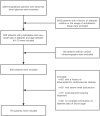A High Triglyceride-Glucose Index Value Is Associated With an Increased Risk of Carotid Plaque Burden in Subjects With Prediabetes and New-Onset Type 2 Diabetes: A Real-World Study
- PMID: 35310963
- PMCID: PMC8927542
- DOI: 10.3389/fcvm.2022.832491
A High Triglyceride-Glucose Index Value Is Associated With an Increased Risk of Carotid Plaque Burden in Subjects With Prediabetes and New-Onset Type 2 Diabetes: A Real-World Study
Abstract
Background: The triglyceride-glucose (TyG) index has been proposed as a convincing indicator of insulin resistance and has been found to be associated with atherosclerosis among diabetic patients. However, the relationship between the TyG index and arteriosclerosis in subjects with prediabetes and new-onset type 2 diabetes (T2D) remains uncertain. The purpose of this study was to assess the degree of carotid plaque burden in patients with prediabetes and new-onset T2D and to investigate the association between the TyG index and the degree of carotid plaque burden in this population.
Methods: This was a cross-sectional observational study that included 716 subjects aged 40-70 years old with prediabetes or new-onset T2D. Demographic, anthropometric, and laboratory measurements were collected. Participants underwent carotid arteriosclerosis evaluation by ultrasonography, and the degree of atherosclerosis was evaluated according to the carotid plaque burden. The TyG index was calculated.
Results: The population was stratified into high or low TyG index groups according to the median TyG index value. Higher values were associated with a higher BMI and waist circumference as well as higher total cholesterol, triglyceride, low-density lipoprotein cholesterol, plasma glucose, glycated hemoglobin, fasting C-peptide, and C-reactive protein levels (P < 0.001). The high TyG index group had a higher atherosclerotic plaque burden than the low TyG index group (P < 0.001). Multiclassification logistic regression analysis showed that the TyG index was positively associated with a high plaque burden [odds ratio (OR): 16.706, 95% confidence interval (CI): 3.988-69.978, P = 0.000], while no association was found between the TyG index and a low/moderate plaque burden. This association remained consistent in the subgroup analysis. In multiple linear regression analysis, sex, age, and the TyG index were found to be independently associated with carotid plaque burden. For each unit increase in the TyG index, the risk of a high carotid plaque burden increased 1.595-fold.
Conclusion: A high TyG index was positively associated with a high carotid plaque burden in subjects with prediabetes and new-onset T2D. Clinicians should pay close attention to the TyG index to help these patients receive the greatest benefit from early intervention.
Keywords: atherosclerosis; carotid plaque; new-onset type 2 diabetes; prediabetes; triglyceride-glucose index.
Copyright © 2022 Jiang, Zhu, Shen, Zhao, Tang, Tang, Liu and Jiang.
Conflict of interest statement
The authors declare that the research was conducted in the absence of any commercial or financial relationships that could be construed as a potential conflict of interest.
Figures



Similar articles
-
Clinical features of early-onset type 2 diabetes and its association with triglyceride glucose-body mass index: a cross-sectional study.Front Endocrinol (Lausanne). 2024 Mar 11;15:1356942. doi: 10.3389/fendo.2024.1356942. eCollection 2024. Front Endocrinol (Lausanne). 2024. PMID: 38529395 Free PMC article.
-
Association between the triglyceride-glucose index and carotid plaque incidence: a longitudinal study.Cardiovasc Diabetol. 2022 Nov 15;21(1):244. doi: 10.1186/s12933-022-01683-6. Cardiovasc Diabetol. 2022. PMID: 36380351 Free PMC article.
-
Association between triglyceride-glucose index and carotid atherosclerosis in patients with psoriatic arthritis.Rheumatology (Oxford). 2023 Nov 2;62(11):3584-3591. doi: 10.1093/rheumatology/kead100. Rheumatology (Oxford). 2023. PMID: 36897031
-
Triglyceride-glucose index predicts independently type 2 diabetes mellitus risk: A systematic review and meta-analysis of cohort studies.Prim Care Diabetes. 2020 Dec;14(6):584-593. doi: 10.1016/j.pcd.2020.09.001. Epub 2020 Sep 12. Prim Care Diabetes. 2020. PMID: 32928692
-
Triglyceride-glucose index and the incidence of atherosclerotic cardiovascular diseases: a meta-analysis of cohort studies.Cardiovasc Diabetol. 2021 Apr 3;20(1):76. doi: 10.1186/s12933-021-01268-9. Cardiovasc Diabetol. 2021. PMID: 33812373 Free PMC article. Review.
Cited by
-
Correlation between triglyceride glucose index and collateral circulation formation in patients with chronic total occlusion of coronary arteries in different glucose metabolic states.Cardiovasc Diabetol. 2024 Jan 13;23(1):26. doi: 10.1186/s12933-023-02080-3. Cardiovasc Diabetol. 2024. PMID: 38218859 Free PMC article.
-
Association of triglyceride-glucose index with atherosclerotic cardiovascular disease and mortality among familial hypercholesterolemia patients.Diabetol Metab Syndr. 2023 Mar 9;15(1):39. doi: 10.1186/s13098-023-01009-w. Diabetol Metab Syndr. 2023. PMID: 36895032 Free PMC article.
-
Association of triglyceride-glucose index with coronary severity and mortality in patients on dialysis with coronary artery disease.Eur J Med Res. 2023 Oct 17;28(1):437. doi: 10.1186/s40001-023-01410-1. Eur J Med Res. 2023. PMID: 37848993 Free PMC article.
-
Associations of the triglyceride-glucose index and remnant cholesterol levels with the prevalence of Carotid Plaque in patients with type 2 diabetes: a retrospective study.Lipids Health Dis. 2025 Jan 27;24(1):26. doi: 10.1186/s12944-025-02449-1. Lipids Health Dis. 2025. PMID: 39871275 Free PMC article.
-
The study on risk assessment of carotid plaques in the Northern Chinese population based on LASSO regression.Sci Rep. 2025 May 12;15(1):16391. doi: 10.1038/s41598-025-99723-0. Sci Rep. 2025. PMID: 40355716 Free PMC article.
References
-
- Spencer LJ, Degu A, Kalkidan Hassen A, Solomon MA, Cristiana A, Nooshin A, et al. . Global, regional, and national incidence, prevalence, and years lived with disability for 354 diseases and injuries for 195 countries and territories, 1990-2017: a systematic analysis for the Global Burden of Disease Study 2017. Lancet. (2018) 392:1789–858. 10.1016/s0140-6736(18)32279-7 - DOI - PMC - PubMed
-
- Fiorentino TV, Succurro E, Andreozzi F, Sciacqua A, Perticone F, Sesti G. One-hour post-load hyperglycemia combined with HbA1c identifies individuals with higher risk of cardiovascular diseases: cross-sectional data from the CATAMERI study. Diabetes Metab Res Rev. (2019) 35:e3096. 10.1002/dmrr.3096 - DOI - PubMed
LinkOut - more resources
Full Text Sources
Research Materials

